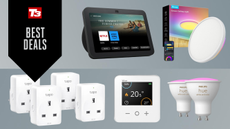Smart Home
The latest Smart Home breaking news, comment, reviews and features from the experts at T3
-

EE just gifted UK broadband customers with a Wi-Fi 7-flavoured upgrade
All of EE's full fibre broadband plans now come with Wi-Fi 7 routers as standard
By Rik Henderson Published
-

Your Echo Show can now automatically buy things for you, thanks to Alexa+
This Alexa+ upgrade makes shopping quicker and easier than before
By Bethan Morgan Published
-

Xiaomi’s futuristic triple-drum washing machine is now available to buy – here's how much it costs
Yep, that means you can wash three loads at the same time
By Lizzie Wilmot Published
-

The discounts didn’t stop at Black Friday – here are 5 incredible smart home deals still live on Amazon
You can still grab a bargain
By Lizzie Wilmot Published
-

The brilliant Echo Spot is back to its lowest price and it's the best bedside assistant around
An ideal gift to get Alexa on your bedside
By Chris Hall Published
-

‘Alexa, play KPop Demon Hunters’ – Amazon reveals Alexa’s most asked questions of 2025
Alexa’s most asked questions of 2025 probably won’t surprise you
By Bethan Morgan Published
-

Govee has some impressive new smart lights on the way – and they could be here very soon
All has been revealed on the CSA’s database
By Lizzie Wilmot Published
-

Google speeds up Gemini for Home rollout for its speakers and displays – but when will you get it?
Gemini for Home is on its way, now faster than ever
By Bethan Morgan Published
-

Philips Hue Secure 2K Wired Camera review: a perfection companion to your Philips Hue smart lights
Expand your Philips Hue smart home system with this camera
By David Nield Published
-

Best Dyson fan 2025: cool, heat and purify the air with picks from Dyson
Find the best Dyson fans and air purifiers for your home in T3's comprehensive guide
By Bethan Morgan Last updated
-

Best portable air conditioner 2025: premium and versatile cooling devices for your home
Stay cool and comfortable with the best portable air conditioner you can buy
By Bethan Morgan Last updated
-

Best fan 2025: cooling gadgets for summertime and all-year-round relief
Find the best fans – desktop, tower, evaporative, you name it – from Dyson, Meaco and many more
By Bethan Morgan Last updated
-

Ring doorbells get a major new update – although some might not welcome it with open arms
But it matches the best feature of Nest doorbells
By Chris Hall Published
-

Philips Hue's new app update just arrived – and it's the best one we've had in ages
Version 5.57.0 is available now from the Apple App Store and Google Play Store
By Lizzie Wilmot Published
-

Xiaomi’s new smart fridge has some brilliant features – and it could shape the future of kitchen appliances
It's also incredibly affordable
By Lizzie Wilmot Published
-

Best security camera 2025: protect your home with top smart wireless cameras
Find the best indoor and outdoor security cameras that detect and capture motion and sound, to keep your property safe
By Bethan Morgan Last updated
-

I’m a smart home expert – here are 3 trends I’m hoping to see in 2026
Could this be the year my smart home wish list goes from dream to reality?
By Lizzie Wilmot Published
-

Ring wants to bring back Christmas carol singing by giving away free Video Doorbells
You can get a free Ring video doorbell this week by carol singing – here’s how
By Bethan Morgan Published
-

Samsung’s Ballie home companion robot has been delayed yet again
When can we expect to buy the Samsung Ballie?
By Bethan Morgan Published
-

IKEA quietly launches new LED light with built-in sensor – and it's only £3
That's for a 2-pack!
By Lizzie Wilmot Published
-

6 smart home devices you need to upgrade your house for Christmas hosting
Sit back and relax while your smart home does the Christmas work
By Max Slater-Robins Published
-

Google Home app removes its ‘Call Home’ feature – and people aren’t happy
‘Call Home’ and ‘Broadcast’ has disappeared from Google Home
By Bethan Morgan Published
-

This Honeywell Home smart thermostat has a cool touchscreen which live streams your video doorbell
Honeywell Home debuts X8S smart thermostat – and it might be its smartest yet
By Bethan Morgan Published
-

Arlo Essential 3 2K Pan-Tilt Security Camera review: well priced camera with useful AI smarts
This budget-friendly pan-tilt camera promises wall-to-wall 2K coverage and clever AI alerts – but can it really give Ring a run for its money?
By Lee Bell Published
-

This Google hack could give you early access to Gemini for Home – but it might not work for everyone
Want access to Gemini for Home early? This hack could be the answer
By Bethan Morgan Published
-

The Homey Pro Mini has arrived in the UK and Europe – it's the perfect gadget to start your smart home
It was launched in the US late last year
By Lizzie Wilmot Last updated
-

Aqara upgrades its S1 Plus smart hub with Siri support – Apple users should be excited
Aqara’s smart home hub now comes with Siri built in
By Bethan Morgan Published
-

eufyCam S4 review: a motorised, triple-lens 4K security camera
From solar and 4K to a 3x zoom and AI, this is the only home security camera you’ll ever need
By Alistair Charlton Published
-

Best air purifier 2025: remove allergens, particles and pollution from your home
Improve the quality of the air you breathe with the best air purifiers from Blueair, Dyson, Philips and more
By Bethan Morgan Last updated
